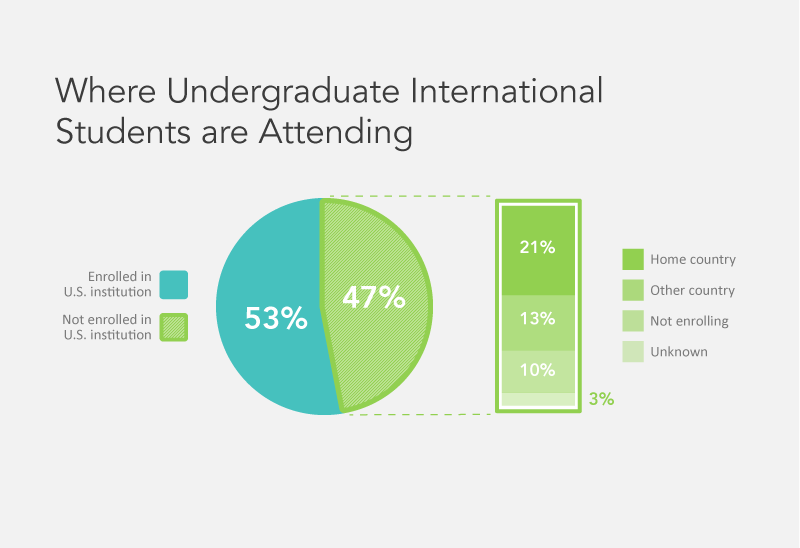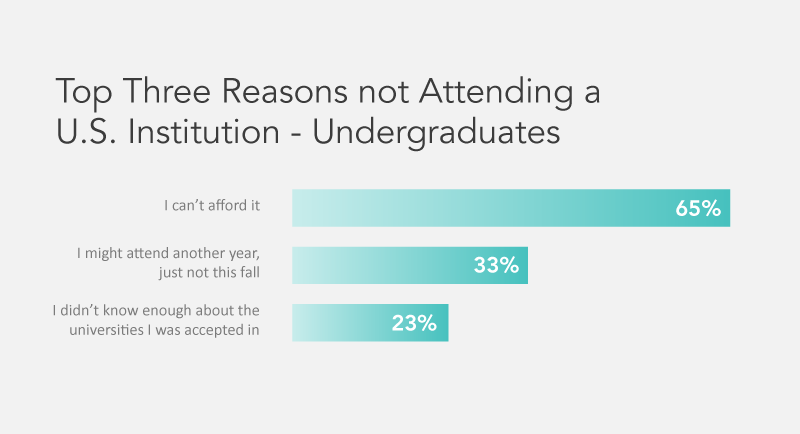This summer, China has been in economic turmoil. Legions of Chinese international students must also be in turmoil. Those who are enrolled in U.S. institutions are seeing their tuition costs skyrocket due to devalued currency. Those who are considering a U.S. higher education are seeing the cost barrier to entry rise.
To be sure, there is enough wealth in China to sustain the river of students flowing to the U.S., but will this turmoil diminish the flow? Economics are only one influence on international students’ decisions. With 31% of international students coming from China, according to The Institute of International Education’s most recent “Open Doors” report, however, a reduction in Chinese students’ ability to pay is cause for concern.
This moment in China’s economic trajectory, which has ripple effects on many other countries’ economies, illuminates larger concerns about international student enrollment. International students have unrealistic expectations about their capacity to study in the U.S., and U.S. institutions have unrealistic expectations of unfettered growth in international enrollments. Even though studying in the U.S. is competitively priced compared to studying internationally in many other countries, international students have many choices, making for a dynamic competitive landscape.
Cost as a factor for non-enrollment
We’ve seen evidence of these mismatched expectations even before this summer’s economic turmoil abroad. In May, Eduventures and CollegeWeekLive sponsored a study of undergraduate and graduate international students admitted for the fall of 2015. It is one of the few studies to explore the factors influencing international students’ final enrollment decisions. The results indicate that nearly half (47%) of undergraduate international admitted students did not choose to attend a U.S. institution.
We might be satisfied with an overall 53% yield, but the underlying reason for non-enrollment is concerning. The vast majority (65%) of undergraduate students who did not enroll in a U.S. institution cited cost as one of the deciding factors. One-third deferred their decision to another year, and almost one-quarter felt they didn’t know enough about the institutions where they were accepted to make a good decision.
Give students enough information to make informed decisions
This data reveals deep inefficiencies in U.S. international recruiting efforts in that so many international students go all the way through applying to U.S. institutions only to face an easily predictable reality. We know how much it will cost international students to study in our institutions. U.S. institutions have precious little financial aid available to international students. If they don’t come from families with substantial means or have the support of their government, they are unlikely to be able to afford a U.S. education. Knowing all of this, U.S. institutions must engage in a transparent conversation about cost early on in the recruiting cycle. This will enable them to not only find truly qualified international applicants, but also ethically recruit international students. We shouldn’t lead students down the garden path. It’s bad for students, and it’s bad for the brand.
We should consider the brand—that is, the global brand of U.S. higher education. We’ve long enjoyed reputational front-runner status among students seeking to study outside of their home countries. In many countries, though, students have ever-increasing options. In our study, students who didn’t enroll in the U.S. and didn’t stay in their home countries chose to study in Canada, the U.K., Australia, and Germany in sizeable numbers.
As the competition for international undergraduate students heats up, we have two threats to address in international recruiting. The first, affordability, is endemic to higher education for any international student. The second, good communication, is a ubiquitous problem for higher education in recruiting any student, domestic or international.
In the long run, affordability presents an existential threat to the brand of U.S. higher education in a competitive environment. As institutions in other countries build their efforts to enroll international students, the price of U.S. higher education may cause some students to think twice about their choice. U.S. institutions often look at international enrollment as a way to solve revenue problems without due consideration of how to support and develop international students properly. We would do better to view internationals as students first, with all their attendant needs and expectations. This will improve our ability to serve international students at a high standard in order to retain a competitive advantage, even at high cost.
Ultimately, cost will always be a concern for international students. Thus, we must communicate both the opportunity and the realistic costs as prospective international students progress through the enrollment funnel. Better communication is certainly something that every institution can achieve. We now have access to many more tools to engage international students at a distance. We can train our recruiters, tailor our messages, learn to work well with reputable agents, tune up our websites for international audiences, and create virtual opportunities for international students to engage in the transparent conversations they need. In the end, we want international students to choose our institutions if they can afford it. We don’t want them to reach the end of the line and achieve their goal, only to be disappointed by their inability to attend because of cost.



